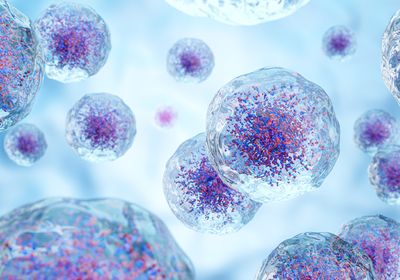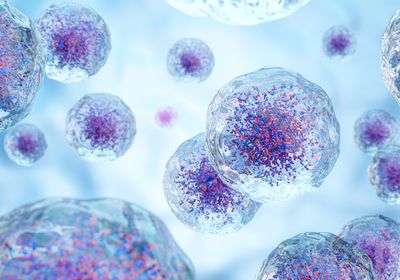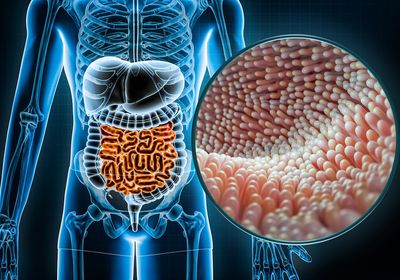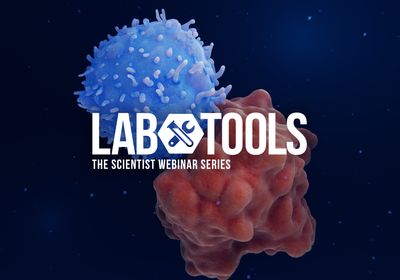ABOVE: Acute myeloid leukemia cells share common surface markers with healthy hematopoietic stem and progenitor cells, making the disease difficult to treat. © iStock, stockdevil
Acute myeloid leukemia (AML) is a deadly disease that presents unique treatment challenges. The cancerous hematopoietic stem and progenitor cells (HSPC) can be treated using chimeric antigen receptor (CAR) T cell therapy, but not in a targeted manner; the AML markers recognized by these therapies are also expressed by healthy HSPC and differentiated myeloid cells. This makes it impossible for current treatments to selectively kill the cancer cells, which causes significant toxicity and prevents successful HSPC transplant.1
In a study published in Nature, researchers from the Dana-Farber Cancer Institute and Harvard Medical School addressed this key obstacle.2 Editing specific epitopes of receptors expressed on the surfaces of healthy donor HSPC rendered the cells resistant to CAR T cell therapy.
“Prior to this study, it was not very well characterized that it’s possible to abrogate the binding of therapeutic antibodies or CAR T cells with just one amino acid change in the extracellular domain of a protein,” said hematologist and coauthor Gabriele Casirati of the Dana-Farber Cancer Institute. “That was one of our main discoveries.”
Casirati and his colleagues selected three well characterized AML surface markers that are currently being targeted with CAR T cell therapy: FMS-like tyrosine kinase 3 (FLT3/CD135), KIT (CD117), and the α subunit of the IL-3 receptor (IL-3RA; also known as CD123). These proteins associate with almost all cases of AML and their overexpression on AML cells correlates with relapse and low survival rates, but they are also expressed in healthy cells at various stages of hematopoiesis.
The research team extensively screened cells for possible mutation sites in the genes encoding the surface markers. They hoped to identify sites that prevented the antibody portion of the CAR T cells from binding to them without interfering with the genes’ other critical cellular functions.
For each gene, they identified several such possible mutation sites. “We were lucky enough that at least some of these mutations could be inserted by adenine base editing,” Casirati explained. “We tried conventional nuclease-based editing, but avoiding double-strand breaks is fundamental [for safety] so I wanted to go with the least toxic possible gene editing technology.”
Using this information, the team performed adenine base editing of the epitopes in healthy human HSPC, creating a stealth version of each receptor. 3 While the majority of nonedited HSPC were killed by CAR T cells directed against the markers in in vitro assays, epitope-edited cells survived. Each line of edited cells also maintained its stemness and differentiation capacity.
To minimize the chance of tumor escape and prevent relapse, CAR T cell therapies can target more than one AML marker. This led the team to produce cells expressing multiple edited epitopes. Casirati emphasized that the success of multiplexed editing is a key finding of the paper; using a mouse model, he and his team found that dual-edited FLT3 and CD123 HSPC survived in the presence of bispecific CAR T cell therapy targeting both markers. This approach fully eradicated AML cells in the tested tissues.
“This paper is state-of-the-art in terms of doing epitope editing of these hematopoietic stem and progenitor cells that will still preserve their normal hematopoietic function,” said Jeffrey Taub, a pediatric oncologist at Wayne State University who was not involved in the research. “Definitely also, in terms of being able to target multiple genes simultaneously for AML with immunotherapies, [that] would be much more effective than only targeting one gene.”
Casirati said that the study has implications that reach far beyond the treatment of AML. “In the broader sense, [our work] is one of the first papers that shows how we can manipulate healthy tissues to endow them with new functions,” he concluded.
References
- Hansrivijit P, et al. Cellular therapy for acute myeloid Leukemia – Current status and future prospects. Blood Rev. 2019;37:100578.
- Casirati G, et al. Epitope editing enables targeted immunotherapy of acute myeloid leukaemia. Nature. 2023;621:404-414.
- Richter MF, et al. Phage-assisted evolution of an adenine base editor with improved Cas domain compatibility and activity. Nat Biotechnol. 2020;38(7):883-891.








